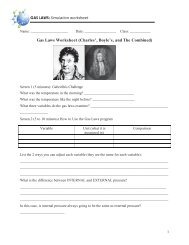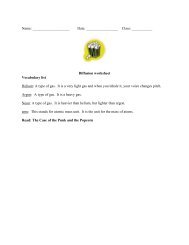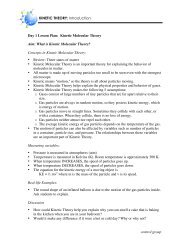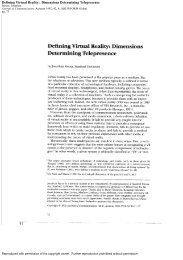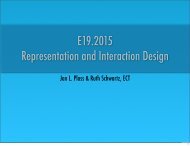PHASE CHANGE
PHASE CHANGE
PHASE CHANGE
Create successful ePaper yourself
Turn your PDF publications into a flip-book with our unique Google optimized e-Paper software.
<strong>PHASE</strong> <strong>CHANGE</strong>: Simulation worksheet<br />
Name: ____________________ Date: _________________ Class: ___________<br />
Phase Change Worksheet Concept of Variation during Phase Change: How are internal energy<br />
and Temperature Related?<br />
Vocabulary list:<br />
Manipulated: Changed, or modified<br />
Chlorine: It is a molecule or substance that is always paired up, it looks like this: 00<br />
Bromine: It is a molecule or substance that is always paired up. It has more mass and it is bigger<br />
than chlorine.<br />
Iodine: It is a molecule or substance that is always paired up. It has more mass and it is bigger<br />
than bromine.<br />
Explain, USING COMPLETE SENTENCES, why Gabriella is ‘beasting’ or ‘tripping’? (Tell me<br />
why she is complaining).<br />
______________________________________________________________________________<br />
______________________________________________________________________________<br />
Is heat matter or non-matter? _______________________<br />
Heat is a process for _________________ energy.
<strong>PHASE</strong> <strong>CHANGE</strong>: Simulation worksheet<br />
What 3 variables will you be studying in this simulation? ______________ _________________<br />
_______________<br />
What are the units of heat? (What is heat measured in?) ___________________ (write out the<br />
whole word).<br />
What 3 elements are we using in this simulation? _____________ _________________<br />
________________<br />
Phase Change simulation (25 minutes)<br />
Which element is composed of molecules with the smallest mass? _______________________<br />
Which element is composed of molecules with the largest mass? ________________________<br />
Before you answer any further questions, please turn on the heat and watch the<br />
molecules and the graph. Think about the definitions of the different phases of matter (solid,<br />
liquid, gas).
<strong>PHASE</strong> <strong>CHANGE</strong>: Simulation worksheet
<strong>PHASE</strong> <strong>CHANGE</strong>: Simulation worksheet
<strong>PHASE</strong> <strong>CHANGE</strong>: Simulation worksheet
<strong>PHASE</strong> <strong>CHANGE</strong>: Simulation worksheet
<strong>PHASE</strong> <strong>CHANGE</strong>: Simulation worksheet<br />
Lesson Plan: Lauric Acid Lab<br />
Aim: Can you recreate the phase change graph in the real world?<br />
Your Name: ________________________ Date: ______________<br />
Lab Partners: __________________________________<br />
Introduction: You know that matter can exist in one of three physical states—solid, liquid, or<br />
gas. For a pure substance, changes in state occur at a definite temperature, which is a physical<br />
property of that substance. Water, for example, changes from a solid to a liquid at 0(C.<br />
In a solid, the particles are arranged in an orderly, repeating, three-dimensional pattern. As the<br />
solid is heated, the energy of the particles increases. Eventually, at some temperature, which is<br />
called the melting point, the molecules overcome the forces of attraction holding the particles<br />
together, and the substance changes to a liquid. At another temperature, called the boiling point,<br />
molecules in the liquid state overcome the forces of attraction between them and the substance<br />
changes from a liquid to a gas.<br />
When a liquid is cooled, the reverse process occurs. The temperature of the gas decreases until<br />
the condensation point is reached and the gas becomes a liquid. Only after the gas has completely<br />
changed to a liquid will the temperature decrease again. The temperature of the liquid decreases<br />
further until the freezing point is reached. Only after the liquid is completely changed to a solid<br />
will the temperature begin to decrease further.<br />
Purpose: Changes of state (phase changes) occur in the change between solid and liquid and<br />
liquid and gas. In the phase change simulation you observe a change between liquid and gas. In<br />
this activity, you will observe what happens as lauric acid (C12H24O2) melts. You will measure<br />
the temperature at timed intervals as the lauric acid is heated to determine its melting point<br />
experimentally (What other strategies could you use to find out a temperature for the melting<br />
point of lauric acid? Why are both useful?)<br />
Pre-Lab:<br />
1. What phase is the lauric acid in at the beginning of the lab? ________________<br />
2. What will be the next phase the acid changes to when you add heat? _________________<br />
3. Based on the simulations we did yesterday, predict the shape of its heating curve:
<strong>PHASE</strong> <strong>CHANGE</strong>: Simulation worksheet<br />
4. What are the independent and dependent variables?<br />
Independent: ________________<br />
Dependent: __________________<br />
5. What do you always need to wear while chemicals are on the lab tables? Why?<br />
_______________________________________________________________________<br />
Materials:<br />
goggles<br />
lauric acid test tube<br />
2 beakers, 400 mL<br />
thermometers<br />
hot plate<br />
tap water<br />
ice for ice bath<br />
Procedure:<br />
1. Put on goggles.<br />
2. Fill one 400 mL beaker _ full of tap water and heat it on the hot plate. Turn the hot plate all the<br />
way to 10. Once you see tiny bubbles, turn it down to 6. CAUTION: Do not touch the hot plate<br />
or beaker.<br />
3. At the same time make an ice bath using a 400 mL beaker and ice from the front desk.<br />
4. Get a large test tube of lauric acid and hold it with a test tube holder. Place it in the hot water<br />
bath. (You need to melt the lauric acid so you can insert the thermometer into the acid)<br />
5. As the solid begins to melt, place a thermometer into the test tube, once you are able to insert<br />
the thermometer (see diagram on previous page), use the test tube holder to place the test tube in<br />
an ice water bath. Stop once the temperature reaches about 30(C.<br />
6. Carefully place the test tube containing the lauric acid back into the hot water bath (it should<br />
NOT be boiling).<br />
7. Immediately begin to take temperature readings every 30 seconds. Record your temperatures<br />
and time in the data table provided.<br />
8. Begin stirring gently as soon as you are able to move the thermometer easily. Continue to
<strong>PHASE</strong> <strong>CHANGE</strong>: Simulation worksheet<br />
measure and record the temperature until the lauric acid is at approximately 55(C.<br />
9. Turn off the hot plate. Remove the thermometer from the lauric acid and return test tube to<br />
your teacher.<br />
10. Clean up your work station and wash your hands.<br />
Observations:<br />
Approximate melting point of lauric acid _____________<br />
Describe the changes you witnessed?<br />
_______________________________________________________________________<br />
______________________________________________________________________________<br />
________________________________________________________________<br />
Could you see the actual molecules? Why or why not?<br />
_______________________________________________________________________
<strong>PHASE</strong> <strong>CHANGE</strong>: Simulation worksheet<br />
Why do you need to record so many points?<br />
______________________________________________________________________________<br />
______________________________________________________________________________
<strong>PHASE</strong> <strong>CHANGE</strong>: Simulation worksheet<br />
Draw a graph representing the table on the previous page. You MUST label all axes, put in the<br />
scale, and write a title.<br />
Think About it:<br />
1. Did you prediction match your actual data? ____________ Why do you think it was the<br />
same or different?<br />
______________________________________________________________________________<br />
______________________________________________________________________________<br />
___________________________________________________________________________
<strong>PHASE</strong> <strong>CHANGE</strong>: Simulation worksheet<br />
2. What was difficult about the procedure (measuring the temperature, keeping the time,<br />
etc...)?<br />
_____________________________________________________________________________<br />
_____________________________________________________________________________<br />
3. How can you explain the fact that at its melting point the temperature of the lauric acid<br />
did not change even though you were still adding heat? What is happening to the heat energy you<br />
are putting into the lauric acid:<br />
When it is a solid?<br />
__________________________________________________________________________<br />
________________________________________________________________________<br />
When it is changing from solid to liquid? [What is happening to the forces of attraction between<br />
the lauric acid molecules?]<br />
__________________________________________________________________________<br />
__________________________________________________________________________<br />
When it is a liquid?<br />
__________________________________________________________________________<br />
__________________________________________________________________________<br />
4. What were the similarities and differences between what we did in the simulation<br />
yesterday and the lab we did today?<br />
________________________________________________________<br />
______________________________________________________________________________<br />
____________________________________________________________________________<br />
5. How did the simulation help you understand what is happening to the lauric acid as it<br />
melts? Give specific details<br />
___________________________________________________________<br />
.____________________________________________________________________________<br />
____________________________________________________________________________<br />
6. The simulation you did yesterday is a model that explains the relationship between heat<br />
and temperature during a phase change. Why do you think scientists need to test things<br />
theoretically and also do actual experiments?<br />
______________________________________________________________________________
<strong>PHASE</strong> <strong>CHANGE</strong>: Simulation worksheet<br />
______________________________________________________________________________<br />
___________________________________________________________________________<br />
7. Draw particle diagrams of what you think the molecules will look like as a solid and as a<br />
liquid:



